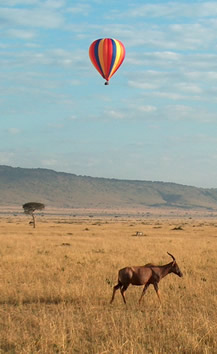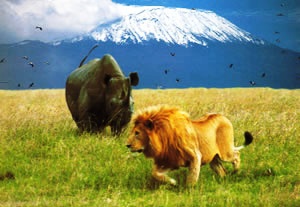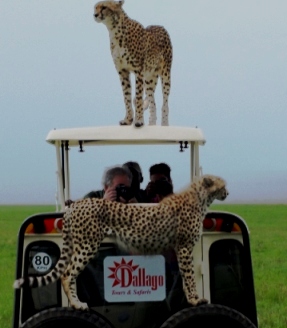Kenya Wildlife Parks and Games reserves - lions, Elephants, Giraffes, the big five,
KENYA NATIONAL PARKS AND RESERVES
 Kenya has for long been regarded as the "Home of African Wildlife Safari". Her national parks and reserves are among the best in Africa. Obviously flora and fauna is the main attraction. The parks hold variety of animal species ranging from the Big Five to the tiny antelopes such as the dik-dik - slightly larger than a rabbit.The sight of annual migration of millions of wildebeests and zebras into the Masai Mara from Tanzania's Serengeti National Park can be a lifetime experience for you.
Kenya has for long been regarded as the "Home of African Wildlife Safari". Her national parks and reserves are among the best in Africa. Obviously flora and fauna is the main attraction. The parks hold variety of animal species ranging from the Big Five to the tiny antelopes such as the dik-dik - slightly larger than a rabbit.The sight of annual migration of millions of wildebeests and zebras into the Masai Mara from Tanzania's Serengeti National Park can be a lifetime experience for you.
There are over 1000 species of bird which makes Kenya perhaps the finest country in Africa for bird watching.
Some parks have been created to preserve the landscape itself, and these too can be exciting and rewarding places to visit, such as Mount Kenya, Mount Elgon, Hell's Gate, Mount Longonot and the Kakamega Forest are all worth investigating.
Marine life is also in abundance and the marine national parks of Malindi and Watamu off the central coast, both offer excellent diving possibilities.
There are varieties of accommodation within the park and reserves ranging from budget to luxury, which are a real experience too.
On safari in Kenya, you will find spectacular mountain sceneries, fabulous beaches and coral reefs, magnificent lakes and deserts, and widespread savannah grassland.
Kenya also has remarkable multi-ethnic cities, known for their rich and charming culture and architecture
Below are some brief descriptions of some of the famous National Reserves and Parks in Kenya. For more detailed information please email us
The Masai Mara Game Reserve
 The Masai Mara game Reserve is the most famous and most visited Reserve in Kenya. It offers breathtaking views (as seen in the film "Out of Africa", much of which was filmed here), an extraordinary density of animals including "the Big Five" (lions, leopard, elephant, buffalo, rhinoceros) and may varieties of plains game.
The Masai Mara game Reserve is the most famous and most visited Reserve in Kenya. It offers breathtaking views (as seen in the film "Out of Africa", much of which was filmed here), an extraordinary density of animals including "the Big Five" (lions, leopard, elephant, buffalo, rhinoceros) and may varieties of plains game.
An impressive feature is the annual migration of wildebeests, zebras and gazelles from the plains of the Serengeti that cross the Tanzanian border and rivers to reach the Mara's grasslands from late June, tracked by predators: lion, leopard, cheetah, and hyena, and circled by vultures as their journey unfolds. Their dramatic river crossings are a reality for tourists visiting in early July-August.
Apart from the seasonal migration, gameviewing is excellent year round. Game includes elephant, black rhino, buffalo, plains zebra, hartebeest and big cats. The rivers are home to hippo and crocodiles. 452 species, 53 of which are raptors.
A well worth it and recommended activity in the Masai Mara National Reserve is the balloon safari. Early in the morning, you will be woken and driven to the departure site. Once in the air, the view of the surrounding landscape, the rising of the sun between the mountains and the congregation of the animals at the river is beautiful. This all concludes with a champagne breakfast and memories of a lifetime.
Amboseli National Park
 This park is south of Nairobi. It is found at the foot of Mt. Kilimanjaro which is 5896m [19341ft], Africa’s highest summit and the highest freestanding mountain in the world because it rises 15,100 feet from its base [4000ft].
This park is south of Nairobi. It is found at the foot of Mt. Kilimanjaro which is 5896m [19341ft], Africa’s highest summit and the highest freestanding mountain in the world because it rises 15,100 feet from its base [4000ft].
Amboseli is one of the most beautiful parks in Africa. This park is famous for its big game – elephants, giraffe, buffalo, lions, and cheetahs – and for its great scenic beauty. It is hard to beat the sight of wild elephants in front of Africa’s most famous mountain, Kilimanjaro. The 3,810sq km of this National park and game reserve encompasses various ecological zones of dry lake bed, acacia woodland, rocky lava strewn, thorn bushes, swamps and mashes and the massif of Oldoinyo Orok rising to over 2,760m. Sun rises and sunsets are romantic with the backdrop of the snow-caped Kilimanjaro.
Samburu and Buffalo Springs and Shaba National Reserves
Just north of Nairobi and Isiolo are the three National Reserves, Samburu, Buffalo Springs and Shaba all of them along the banks of the Ewaso Nyiro River and covering a area of about 300 sq km set in the lands of the colorful Samburu pastoralists close relatives of the Maasai. They are mainly scrub desert and open savannah plain, broken here and there by small rugged hills.
The river supports a wide variety of game and you may see elephant, buffalo, cheetah, leopard and lion as well as dik dik, wart hog, Grevy's zebra and reticulated giraffe. Crocodiles can also be seen on certain sandy stretches of the riverbank. You are guaranteed close up sightings of elephants, reticulated giraffe and various species of smaller gazelle in both Samburu and Buffalo Springs.
Samburu national reserve is famed for rare game species such as the grevy's zebra, long -necked gerenuk, reticulated giraffe and beiza oryx.
Lake Nakuru National Park
This national park is about two hours drive from Nairobi. Famous for the both greater and lesser flamingoes, which cover the lake edge in a layer of bright pink, the fish eating pelicans as well as over 450 other spices of birds. The park has been branded an international bird sanctuary. It becomes the first site to receive such the Important Bird Area (IBA) celebrity status in Africa in recognition of its outstanding value to bird conservation. In the park, the big five and other wild animals can be easily observed.
Lake Nakuru National park also offers a rhino sanctuary.
Hells Gate National Park
Hells Gate is one of the few remaining places in Kenya where you can walk unguided and it's principal feature include Fischer's Tower the central tower and Njorowa Gorges the ancient outlet for Lake Naivasha, long since dried up and now famous for its huge eroded cliffs. Two extinct volcanoes (Olkaria and Hobley's are worth a trip). Natural steam vents rise from fissures in the volcanic rock.
You will also have an opportunity to see wildlife and birds including vultures, Verreaux's Eagles, augur buzzard and swifts. An ideal getaway for a day trip from Nairobi or a stopover en-route to Lake Nakuru or Masai Mara
Mount Kenya National Park
Home to the highest [5, 199m] mountain in Kenya, Mount Kenya National Park contrasts warm savanna with glaciers and snow storms. Both the Kikuyu and Masai regard the mountain as the home of their supreme being, Ngai. It is one of only small number of great mountains whose summit [Point Lenana , the 3rd highest peak] is accessible to non-climbers who are adventures and fit enough.
Spectacular scenery is an important aspect of the park, with lovely lakes, tarns, glaciers, peaks and natural mineral springs in the area. The vegetation naturally varies according to the height. Dry upland forests are found in the lower slopes, which change to montane forest from 2,000m upwards. This forest generally consists of cedar and podo. The vegetation changes to a thick bamboo forest at around 2,500m which, in turn, changes to the upper forest of smaller trees and high altitude moss. Visitors can observe a variety of plants (of at least 11 species) and animals including the black and white Colobus, Sykes monkey, bushbuck, buffalo, and elephant. At lower altitudes, animals like the olive baboon, waterbuck, black rhino, black fronted, duiker, giant forest hog, genet cat, bush pig and hyena are found.
The Aberdares National Park
 This is one of the oldest parks in the country and is famous as the place where Princess Elizabeth became Queen Elizabeth II of England while staying at in the original Treetops Lodge. It is also famous for its prized in habitant, The Bongo Antelope and home to the second largest population of indigenous black rhino. It features miles of high moorland scenery, tumbling waterfalls and sensational views.
This is one of the oldest parks in the country and is famous as the place where Princess Elizabeth became Queen Elizabeth II of England while staying at in the original Treetops Lodge. It is also famous for its prized in habitant, The Bongo Antelope and home to the second largest population of indigenous black rhino. It features miles of high moorland scenery, tumbling waterfalls and sensational views.
Nairobi National Park
Nairobi National Park is the only park in the world within the proximity of a capital city and is Kenya shop window. The park is unique as no where in the world exists a wildlife park with such a variety of animals and birds species so close to the capital city. The flora of the park makes it possible for many different types of wildlife species to co-exist.
The Park has been designated as a rhino sanctuary and more than 50 rhinos had been moved into the park from remote parts of the country, therefore the most ideal place in the country to see the black rhino.
In the park you may also buffalo, lion, cheetah, zebra, giraffe, antelopes and gazelles as well as over 400 species of birds. You should set aside a morning or an afternoon to see it.
Tsavo National Park
This national park is divided in two - Tsavo East & West. The combined area of Tsavo East and Tsavo West National Parks makes Tsavo one of the world's largest game sanctuaries, larger than Wales in Great Britain or Jamaica in the Caribbean. Lying about halfway between Nairobi and Mombasa it covers 20,812 square kilometers. Tsavo East is larger and more arid than Tsavo West.
Tsavo East - is a true wilderness and evokes vivid memories of Africa's forgotten grandeur. Encompassing miles of arid plains, savanna & scrubland and sheltering over 8000 elephants. Tsavo entered 'frontier lore at the turn of the century when two maverick 'man-eating' lions devoured over 50 Indian laborers on the Kenya Uganda Railway.
The main river that passes through this park is the River Galana. A variety of animals can be seen: lions, leopard, cheetah, zebras, giraffes, serval, antelopes, kongoni, lesser kudu, oryx, klipspringer, impala, stripped hyena, ostriches, gazelles, buffalos, elephants and many more. A variety of migratory and native birds are also seen.
Tsavo West - also offers a glorious diversity of habitats but the biggest attraction is Mzima Springs. This is a fount of cool clear water that gushes hundreds of miles from below Mt. Kilimanjaro. It bursts out at a rate of 250 million liters a day, from the rocks at Mzima. Mzima forms a haven for a rich wildlife pageant with elephant soaking half immersed in the waters, light footed but ponderous looking hippo, apparently weightless, tip-toeing across the bottom, crocodiles basking on the bank or swirling through the water; gazelles, zebra and giraffe wandering around the banks through the thick acacias and raffia palms together with hundreds of chattering monkeys and birds.
Mzima is also the main source of Mombasa's water supply. There are well-marked nature trails, an observation platform and an underwater glass tank, which provides a special vantage point to view this remarkable oasis
MERU NATIONAL PARK
 Meru National Park is 35km east of Maua town in the north eastern lowlands below the Nyambeni hills. Of all the Kenya parks, Meru National Park presents the widest variety of landscapes and habitats. Forest, swamp and savannah are pierced by numerous permanent streams, draining from the Nyambenes and flowing in parallel between tounges of lava, south eastwards towards the Tana River.
Meru National Park is 35km east of Maua town in the north eastern lowlands below the Nyambeni hills. Of all the Kenya parks, Meru National Park presents the widest variety of landscapes and habitats. Forest, swamp and savannah are pierced by numerous permanent streams, draining from the Nyambenes and flowing in parallel between tounges of lava, south eastwards towards the Tana River.
Meru National Park holds the Adamson’s falls, the leopard rock and great wildlife. It was where George and Joy Adamson released several hand-reared animals including the famous lioness Elsa [in the book born free]
Game to view includes Lion, Elephant, Cheetah, Leopard and some of the rarer Antelope, Lesser Kudu, some of Kenya's largest herds of Buffalo. The rivers abound with Hippo and Crocodile and 300 species of Birds have been recorded.
Kakamega Forest
 Its situated north-west of Nairobi. The only tropical rainforest in Kenya, left over from past millennia when dense rain forest stretched from West Africa, across Central Africa and into the highland areas on the west and eastern walls of the Great Rift Valley. Rising 4,000 to 7,000 Ft above sea level, the forest has been a protected area of Kenya since its vital role in the eco-system was first recognized in 1933.
Its situated north-west of Nairobi. The only tropical rainforest in Kenya, left over from past millennia when dense rain forest stretched from West Africa, across Central Africa and into the highland areas on the west and eastern walls of the Great Rift Valley. Rising 4,000 to 7,000 Ft above sea level, the forest has been a protected area of Kenya since its vital role in the eco-system was first recognized in 1933.
The Forest's huge variety of birds, reptiles, wildlife, butterflies and insects make it a specialist eco-tourism attraction for bird -watchers and wildlife photographers. Walking beneath the lush forest canopy the deep shade is pierced by flashes of color, exotic birdcalls, the scents of wood, flower and moss.
Recommended Accommodation in Kakamega- Rondo retreat.
Lake Bogoria National Reserve:
Lake Bogoria is a shallow soda lake north of Nakuru Town. It is well known for its hot springs and geysers dotted all around the southern shore of the lake. There are sulphur waters gushing out of the ground and known to have therapeutic values, hence are natural spas and steam baths.
It is the home of Africa’s most magnificent antelope, The Greater Kudu and a host of other savannah wildlife: zebra, impala, Grants Gazelle, Klipspringer, Dik-diks and Monkey among others.The best tour organized by us includes a tour to Lake Bogoria National Reserve along with Lake Baringo.
Lake Baringo
Lake Baringo is a big shallow freshwater lake. It is most famous as an ornithologist's paradise with 500 bird species, hippos and crocodiles are in the lake. The many islands all around also present a nice place to visit.
Mount Longonot National park:
Within the park lies the young dormant Mt. Longonot volcano rising 2,776 above sea level. The park is 90km from Nairobi and offers visitors the opportunity to view Longonot volcano and crater, the Naivasha basin and a splendid view of Rift valley.
Marine Parks and Reserves
Kenya has six (6) Marine National Parks and Reserves and was the first African Country to offer protection to these sensitive aquatic ecosystems.
Malindi marine reserve
Watamu marine reserve
Mombasa Marine Park & reserve
Kisite- Mpunguti reserve
Mpunguti reserve
Kiunga marine reserve





